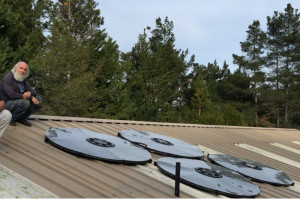
Way back in 1978, I (Larry) installed my first solar water heating system. I continued with solar thermal, installing new domestic hot water (DHW), space, and pool heatin...

Q: What is the difference between solar thermal and solar photovoltaic (PV)?
A: Solar thermal panels heat water. Photovoltaic panels convert sunlight to electricity. This is one of the most frequently asked questions concerning solar from the homeowner perspective.

Q: Which type of thermal panel is better: Flat panel or evacuated tube type collectors?
A:The answer to this question depends on many factors specific to each installation. Here are some of the pros and cons to each type of panel:
Evacuated tubes
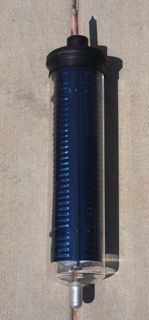
Pros: Evacuated tube technology is the newer and more technologically advanced type of solar thermal panel. Evacuated tube panels have been manufactured since the early 1980’s, but don’t date back as far as the flat panels. The vacuum created between the two layers of glass is a near-perfect insulator. It is beneficial to have a translucent insulator like air to ensure the most amount of sunlight is captured. Evacuated tubes have the best thermal efficiency throughout the year.
An evacuated tube array can easily be put on a roof by one installer. Each tube can be carried individually onto a roof. The assembly process allows for an array to be put together piece by piece instead of one single panel lift.
System overheating should be planned for when installing a solar array. During the peak summer months tubes can be removed if the panels are producing more hot water than is needed. Additionally, if one tube breaks the array can continue to function while waiting for a replacement.
Cons: A major concern is durability. Evacuated tubes have not been on the market nearly as long as flat panels. The downside of a tube made entirely of glass is the extra care needed for them to be transported and handled. A sharp shock or drop can ruin a row of tubes in an instant.
As the glass constantly expands and contracts depending on the heat conditions a rubber housing at the top must remain sealed to keep the vacuum between the layers of glass in the panel. The vacuum is used to lower the boiling point of the fluid inside the heat pipe. The lower boiling point causes the fluid to flash to steam. A concern is that years of ultraviolet radiation could reduce the ability of the rubber to keep its effectiveness. If any part of the rubber grommet leaks the vacuum is lost. When the vacuum is gone so is all the insulation. In addition, some styles of evacuated tubes have a vacuum on the copper heat pipe tube. This is another possible failure point in the panel. If either vacuum is lost the entire tube must be replaced. In the event of a leak or break in the tube it will fog up by releasing barium into the glass in some designs.
Flat Panel Collectors
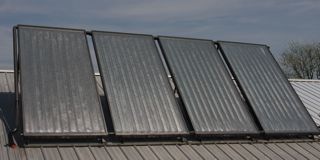
Pros: This technology has been on roofs for over a hundred years. Clarence Kemp of Baltimore, Maryland is a founding father of solar water heating in the U.S. In 1891 he patented the first thermal collector. The flat panel technology has improved but the design is still simplistic. Flat panels are the gold standard in the industry. The design has stood the test of time and is in the fine-tuning stage of its product life.
Flat panels generally consist of copper tubing, insulation, and an enclosure. In the event of damage, a panel can be repaired easily by most contractors. Unlike an evacuated tube, a flat panel does not need to be replaced in the event of minor damage. Overall, flat panels are much more durable than tubes made entirely of glass.
Cons: Flat panels are not as effective in low ambient temperatures, or higher operating fluid temperatures. Some people don’t like the looks of a flat panel array as much as the evacuated tubes.
Flat panels can require more labor to mount. At least two people are needed to hoist a panel onto a roof. In some cases a crane truck can be useful to hoist an array of panels. Hiring a crane truck will speed up the process of hoisting an array and is safer than carrying panels up by hand, but it will add to the cost of the installation.
For comparing performance and other generic data can be found at: http://www.solar-rating.org/
Q: Is solar thermal popular in other parts of the world?
A: In China over 40 million homes have rooftop solar water heaters. Beijing plans to have 300 million square feet of solar thermal panels by 2020. The European Solar Thermal Industry Federation aims for one square meter of solar collector per European citizen by 2020. As of March 2006 a mandate in Spain requires the installation of panels on all new construction projects. The world leader in the amount of solar per person is Israel. (Lester R. Brown, Plan B 3.0: Mobilizing to Save Civilization (New York: W.W. Norton and Company, Earth Policy Institute, 2008)
Q: How long does it take for a solar system to pay itself off?
A: Many variables factor into the time it takes to pay back a solar installation. The cost of other forms of energy needs to be considered. If the installation is in an area with low energy costs the payback will be further out. The amount of sunshine available in the area is another factor to be considered. The return on investment time for an array in Alaska will be much larger than an array in Phoenix.
The cost of the actual system installation is the main factor when estimating payback time. A system with the most advanced components and controllers will have higher efficiency, but will add to the cost and time for payback. The amount labor outside the building will very for each install also. A simple ground array will be require less installation time than an array on the 5th floor of a structure.
The best way to offset the amount of time for solar payback is to use all incentives available in the area of the installation. In some areas local, state and federal tax incentives are available. These incentives are worth the paperwork required to receive them. Information on federal, state and local incentives can be found HERE.
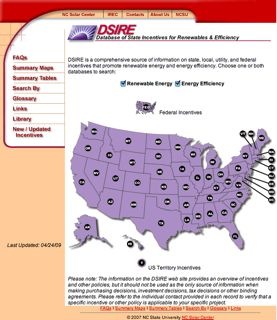
For specific calculations multiple resources are available for estimates. Software programs like RetScreen, F-Chart, T-Sol and various solar manufacture specific programs can help estimate economic parameters. These programs will quantify multiple factors simultaneously. Most of these programs have free demos at their websites.
Q: What makes solar better than other forms of energy?
A: The price of sunlight will never go up. It is a free and abundant resource that does not need to be transported. Even solar photovoltaic and wind power require extensive power grid systems. One of the most attractive aspects of solar energy is the freedom it provides owners from the uncertainty of stock limited resources. Escalating energy costs have proven to drive booms in the solar industry.
Solar appeals to the “green consumer” market. Solar systems allure consumers who will forgive the initial cost of a system to live greener lives. “Going green” is on the forefront of more minds each day in the shadow of the looming climate crisis.
The downside to solar energy is seen during times of stable inexpensive forms of other energy sources. Interest in solar energy is directly tied to the prices of other energy costs. If oil goes back down to $20 per barrel interest in solar thermal may decrease as it did after the 1970’s oil embargos.
Q: Is solar energy a fad?
A: Maybe. Solar thermal energy has had a few ups and downs in the last century. It is highly likely that with the escalating prices of other forms of energy solar will continue to grow. One of the problems with earlier forms of solar thermal systems related to lack of technology and durability. Systems from the 1970’s boom were inefficient and in many cases were not properly installed. Energy awareness seems to be more popular now than ever before. It is trendy to “go green.” This gives the industry a new energized market.
Q: Is it true that sunlight is a weak source of energy?
A: The fusion reactions in the sun produce a surface temperature of 5,700 degrees C. The sun powers the plants, the winds, and the water cycles of the Earth. No other energy resource could power these ecological processes in darkness. The reason solar energy gets the reputation of a weak power lies in the failures of humans to efficiently harness it. (Fred Montague, Environment Notebook: Observations, Principles, Trends, and Ideas about Life on Earth (Salt Lake City: Mountain Bear Ink, 2007)
Q: Can solar thermal be used to generate electricity?
A: Yes. Nevada Solar 1 is an example of a solar thermal power plant. It uses parabolic mirrors in the shape of a trough to focus sunlight to piping containing solar transfer fluid. Other models use flat mirrors to focus the sun energy to a single tower from all angles. The heated fluid is used to convert the energy to steam. Steam spins a turbine, which generates electricity. Recent technology has allowed these plants to run during the night with stored energy to produce a steadier stream of electricity to communities. Technology is making this type of energy generation more consistent and efficient. Unfortunately, the temperatures are so extreme that this type of power generation is not currently practical for residential home use.
Technology in the solar field has improved the efficiency in which humans can harness sunlight. A thermal solar plant in the French Pyrenees can produce temperatures of 3,800 degrees Celsius by using mirrors to focus rays to a single focal point. Less than half the heat from the sun is lost during travel to Earth. Power Plants like this are incredible advancements in the ability to harness the sun.
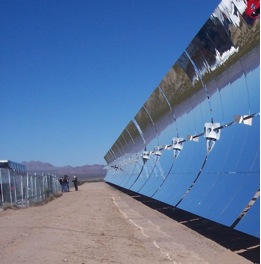
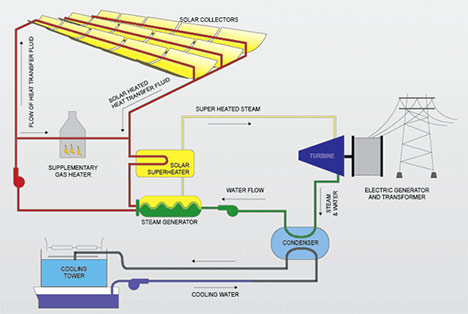
Q: What types of controls can be used for a solar system?
A: A Delta T controller is the most common solar control. A sensor monitors the temperature at the collector and compares it to the temperature at the solar storage tank. When the panel is warmer than the temperature of the tank the pump turns on to harvest the energy. A major reason for a solar controller is to protect the components of the solar system. Stagnant fluid in the panel can flash to steam and damage components. Overheat protection can be accomplished by dumping heat into a pool for example. Modern controllers may have this function available.
A controller also functions to make the system as efficient as possible. A properly functioning controller will prevent panels from cooling water in the solar storage tank. Controllers have seen great levels of improvement and innovation in recent years partly because of microprocessor technology and European influence.
Q: Can solar be used for domestic hot water and heating?
A: Yes. Solar hot water can be used for space heating and/or domestic hot water. Domestic hot water is one of the best applications for solar because it’s a year round load. Space heating generally requires much more panel surface area and storage capacity than simple domestic hot water assistance. Solar space heating is also only useful during the winter months. During the summer large heating arrays need to be protected from overheating issues. Water heated by the solar can be circulated through a radiant floor system or radiators. Systems should be designed to operate at the lowest possible fluid temperatures to leverage solar efficiency.
Q: Can I heat my entire house with solar?
A: Maybe. The first step would be to do a heat load calculation for the building. Using the data from the SRCC or other solar design software you can better estimate the amount of collector area that will be needed.
Q: Does solar thermal work well in cold northern locations?
A: It depends. The National Renewable Energy Laboratory (NREL) has cataloged solar energy available into tables for most of North America. This is a good place to determine how much energy is available in your area month by month. Pay attention to how much the energy drops off during the winter months. View the PDF in Info box in the upper right hand corner of this page.
Q: How do you heat a swimming pool with solar?
A: Swimming pools can be one of the simplest ways to utilize solar. Pool water is directly pumped through the swimming pool panels with no need for a heat exchanger or storage tank. The pool panels are not expensive because they do not need a glass enclosure. In essence, pool panels are simple black plastic mats or tubes that warm water much like a black garden hose in the sun. It is very simplistic solar. If you do install a pool solar system beware that heavily chlorinated water and ultraviolet radiation is hard on plastics.
A swimming pool may also be a perfect location to dump excess heat during the summer months from a DHW or space heating residential array.
Q: Can solar systems be installed without a pump?
A: Yes. These are often called passive solar thermal systems. They operate without need for a pump. They operate with the thermal siphon principle. Warm water rises and cooler water falls causing the fluid to circulate. Passive thermal systems are common in warmer climates where there is no freeze potential.
However, the efficiency of the ground amount array can be lost if the panels are too far away from the tank. Extensive insulation is necessary because the ground will take all the heat out of the water being transported back to the tank. The closer the panel is to the structure the better.
Q: What happens if I don’t have a south-facing roof to put panels on?
A: Panels can be mounted in many different ways. Arrays can be mounted on the ground separate from an existing building. Panels can be mounted vertically on walls. Collectors can mounted as an awning or canopy also.
Panels can also be mounted in various ways on a roof. The best-case scenario is to mount the panel facing directly solar south. Not all structures have good south facing surfaces. Panels can be mounted on the east and/or west side(s) of a roof. Some controllers can easily switch between east and west panels during the day to harvest the most amount of energy. Panels can also be mounted on the north side of a building using a reverse pitch bracket arrangement. With a reverse pitch bracket the panel points south from the north side of the building.
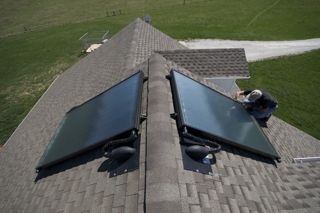
Q: What is the difference between compass south and solar south?
A: To achieve the best efficiency panels should be positioned directly to solar south. However, only a small amount of performance is lost when panels are not directly pointed directly solar south. Declination charts can be found at The National Geophysical Data Center website.
Q: What angle should I mount the solar panels?
A: Panels should be mounted to the degree of your latitude. This provides the best year round performance. However, slight variations off of your latitude decreases efficiency only a small amount. For space heating you may want a steeper angle to take advantage of the winter sun. During the summer they will be closer to vertical and not receive as much excess heat.
Q: What happens if snow collects on top of solar panels?
A: The best plan of action for panels in locations that get lots of snow is the angle of panel installation. Most panel manufactures recommend a panel angle of about 40 degrees from level. Panels at a steep enough angle will shed snow exponentially faster than a panel that is closer to level. Gravity is the easiest way to remove snow from a panel.
Additionally, panels should be mounted far enough above the roof or ground to allow the shed snow to collect below the surface of the panel. Without the room below snow will accumulate as if it had been shoveled there. It is often the case that a pile of snow like this will melt much slower than a single layer. Having a pile of snow touching the panel robs heat and blocks the collector surface area. White snow has a high albedo. This means it repels sunlight more like a mirror. Black surfaces like asphalt and solar panels have a low albedo and absorb a higher percentage of rays.
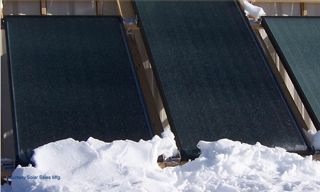
Q: How do I protect my panels from freezing?
A: Freeze protection is not needed in all locations. However, it only takes one freeze to ruin a solar panel. Two methods are commonly used:
A drainback system allows the panels to drain when the pump shuts off. The drainback method provides freeze protection as well as overheat protection. A drainback arrangement may require an additional tank for the water in the panels to drain back to. A drainback system requires more installation care to ensure the piping is sloped properly to the tank. Every inch of piping from the panel down must be properly sloped to ensure the water will gravity flow back down. An improper installation could result in a freeze break. Fewer components are needed to install a drainback system compared to a closed loop glycol system.
Pressurized glycol systems rely on a lower freezing point in the liquid to keep the panel and piping from freezing. To protect systems with glycol, yearly testing should be performed on the pH and freeze protection level of the fluid.
Equatorial locations may not need any freeze protection. However, even Florida freezes from time to time. It only takes one freeze to break a collector or other components. It is not worth ruining a solar panel or other component assuming it won’t freeze.
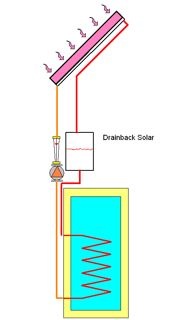
Q: Will hail damage a solar panel?
A: The lower the angle of the panel, the more likely they are to sustain damage from hailstorms. The steeper the angle of the panel the less likely it is to break in a hailstorm. However, a hailstorm that could break the windshield of a car will probably break the glass of a solar panel. Many panel manufactures extensively test their products to hold up to severe weather. Check with the individual manufacturer for specifics about hail.
Q: Can wind rip a panel off a roof?
A: Manufactures build panels and mounting hardware to withstand certain wind loads. This is one of the SRCC requirements for manufactures. You should always check for a SRCC certification label when buying a collector. To ensure the panel stays on the roof stainless steel mounting hardware is recommended. Hardware should account for environmental factors like costal properties, such as salt. Another good procedure is to mount a panel so the top of the panel is lower than the peak of the roof, to avoid wind loading.
Q: Do you need a solar mixing valve when installing a solar system?
A:Absolutely yes. Water from a solar panel can be in excess of 300 degrees Fahrenheit. Solar water must be mixed with cold water to prevent scalding. Make sure you sure you use a quality ASME listed device.
Q: What codes should I adhere to?
A: It depends on your area. Some areas have solar codes regulating installation. In many states codes must be followed in order to receive rebates. Check with the authority having jurisdiction in your area. In some cases building permits may be required.

Way back in 1978, I (Larry) installed my first solar water heating system. I continued with solar thermal, installing new domestic hot water (DHW), space, and pool heatin...
In response to a person on the Wall who asked, "Can I add antifreeze to my heating system?" Brad White replies: Antifreeze is commonly done but like anything else, you ha...
Here is an interesting story for you. Jessica Baldwin told me about the reclamation of these old solar panels. Nothing stands in this woman's way.